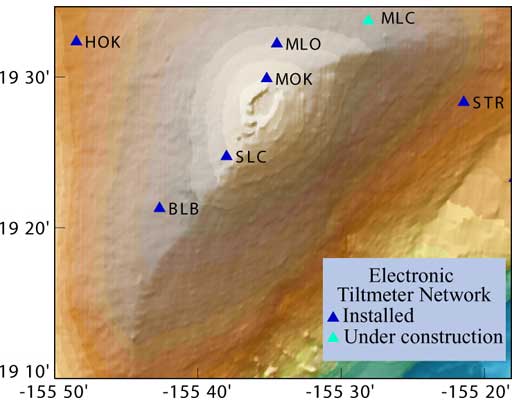
|
|
|
|
Current Activity |
| Current Mauna Loa Data |
| Activity Summary (1974-2002) |
 |
|
We recently expanded our network of continuously recording global positioning system (GPS) stations on Mauna Loa, shown on the map above. The current network can detect changes in the shape of the ground surface due to inflation of both the relatively shallow magma reservoir at the summit and a deeper magmatic system. Several of the new GPS stations are positioned to monitor the potential movement of magma into the northeast and southwest rift zones and into the area of radial vents on the northwest flank. The network is also designed to monitor stress changes in the seismically active Ka`oiki fault zone on the southeast flank. GPS data are usually processed about 24 hours after collection using the rapid satellite orbit information distributed by the Jet Propulsion Laboratory. Final orbits are released about two weeks later and the GPS data are then re-processed. Consequently, the data on the graph for the past two weeks or so should be considered preliminary. Plotted below is the change in distance between the stations (MOKP and MLSP) located on opposite sides of Moku`aweoweo, Mauna Loa's caldera. Over the last several decades, various surveying techniques have shown that an increase in the distance between these two stations is a good indicator of inflation of the summit magma reservoir. In May 2002, the distance between these two stations abruptly began extending, reversing an almost decade-long trend of contraction. Survey GPS measurements of a large network of benchmarks on Mauna Loa, as well as tilt surveys at the summit, have confirmed that this extension is due to influx of magma into the summit reservoir. |

A fairly rapid increase in distance across the summit caldera, 5-6 cm/year, started in May 2002. The rate started to slow in late October 2002 and had flattened by year's end. Starting in early February 2003, the distance began to lengthen again. The extension continued until late August 2004, when, rather abruptly, the distance began to contract. In general, data for the past two weeks shown on this graph are subject to greater error than older data owing to the use of rapid orbit corrections.
For more information on how GPS systems help monitor the deformation of Mauna Loa and Kilauea volcanoes, see a summary of the inflation-deflation of summit magma chambers.
Electronic Tiltmeter Data
 |
|
| We maintain several continuously recording electronic tiltmeters on Mauna Loa. The graph below shows two components of tilt recorded at MLO over the last month. Positive changes on the plot indicate tilting of the ground at the tiltmeter site toward the north and east. The tiltmeter is located northwest of the summit magma chamber, so tilt toward the northwest would indicate inflation of the magma reservoir. Electronic tiltmeters are highly sensitive instruments designed to detect minute changes in a volcano's shape. Unfortunately, this sensitivity makes electronic tiltmeters respond to signals that have nothing to do with volcanic processes -- temperature, for example. As the ground heats and cools it deforms slightly, resulting in a measurable tilt. Consequently, the tilt record contains a diurnal signal corresponding to the daily temperature fluctuations, and an annual signal corresponding to seasonal temperature changes. This makes tiltmeters less useful than GPS receivers for tracking relatively slow, long-lived processes. Rather, tiltmeters excel at imaging fast, short-term events in real-time, giving us the earliest possible warning of changes that could lead to eruption. | |

Tilt as recorded by MLO tiltmeter. No significant volcanic tilt was recorded over the time period shown in this graph. The tilt shown by the two components is seasonal, related to changes in ground temperature at this high (4 km) station. We are looking for abrupt departures from this seasonal trend that will indicate volcanic tilt. Note: Until July 20, 2004, this plot showed the tilt at MLK; instrumental spikes distorted the record frequently, so we decided to show the MLO tilt instead.
For more information on how electronic tiltmeters help monitor the deformation of Mauna Loa and Kilauea volcanoes, see a summary of the inflation-deflation of summit magma chambers.
Current Seismicity
Since a swarm of deep earthquakes centered just south of the caldera in late April 2002, seismicity was at a barely elevated level until July 2004, far lower than those of the months prior to the 1975 and 1984 eruptions. Starting in July 2004, however, a swarm of small (magnitude less than 3), deep (>40 km), long-period earthquakes has been taking place below the southern part of the caldera and adjacent areas. Neither the depth nor the magnitude of the earthquakes has changed during the swarm. In other words, the earthquakes are not becoming shallower or larger.

Contact: hvowebmaster@usgs.gov
Updated: 21 September 2004 (DAS)